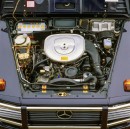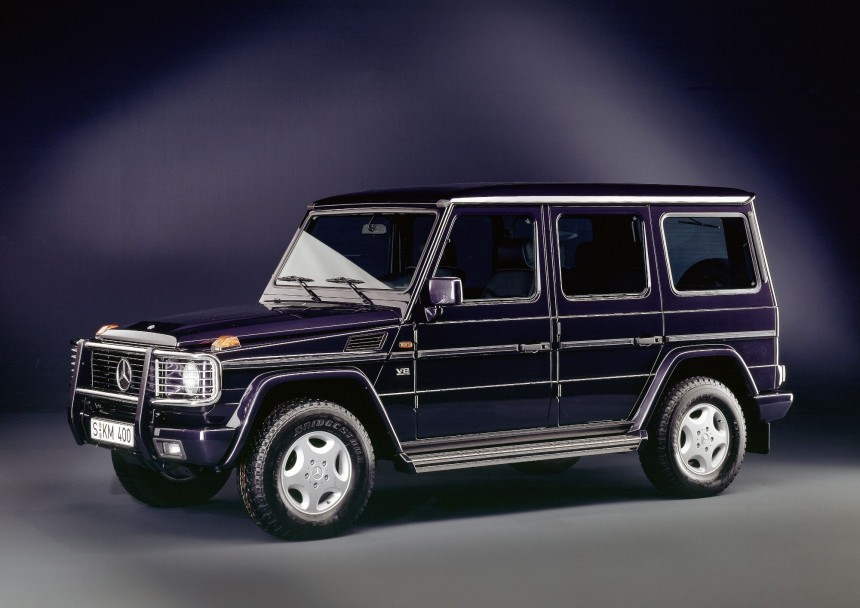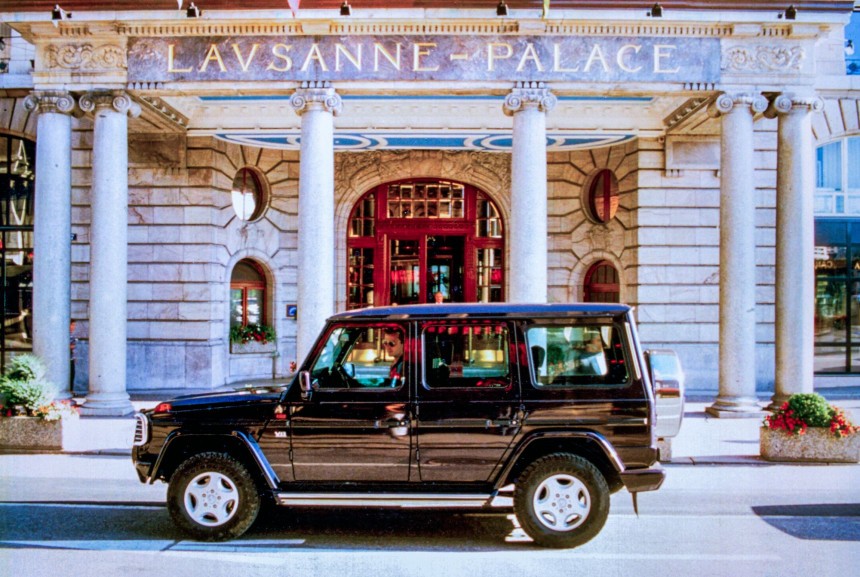The G-Class is Mercedes-Benz’s longest-produced series. Today, I’d like to tell you more about the special model that inspired today’s high-performance G-Classes, the 500 GE V8. But first, a short history lesson on the famous three-pointed star car.
The G-Wagen is the godfather of all the brand's modern SUVs. Launched in 1979, the simple W 460 model series significantly differed from today’s G-Class models in terms of its features. It was engineered for rough everyday use, such as on a farm, forest, or most unpaved roads, and even in the military. Over time, it evolved into the luxury lifestyle vehicle we know.
What helped it achieve this performance is the all-wheel drive, three locking differentials, and the essential rigid ladder-type frame. Even though it could easily go off the beaten path, it could tackle paved roads just as well, keeping you safe in any environment. Regarding its design, it’s actually relatively similar to today’s G vehicles.
A notable result of the W 460 generation was a win at the intense Paris-Dakar rally in 1983 in a Mercedes-Benz 280 GE, the generation’s top gasoline-powered variant. Jacky Ickx and Claude Brasseur of Mercedes-Benz France took the victory in a technically optimized 280 GE.
A testament to the quality of the G-Class series is that 80% of all the vehicles ever produced still exist – that’s an insane percentage, and it's a significant reason why the G-Wagens are so popular.
Mercedes-Benz produces the G models in Graz, Austria. Initially, customers could choose between four diesel and petrol engines with power ranging from 72 ps (71 hp) to 156 ps (154 hp). Several body styles, including Cabriolet and Station Wagon models, were available, with short or long wheelbases.
The evolution toward the technical G model series started with the W 463 model series, which was introduced in 1989. Mercedes-Benz opted for a more comfortable vehicle design, permanent all-wheel drive, and a premium interior.
But the switch to a refined, high-end lifestyle vehicle began in 1993 when Mercedes-Benz unveiled the 500 GE V8 as the new top-of-the-range engine for the G model at the Geneva Motor Show. By then, the G model had built an excellent reputation in the off-road world.
It was the first time the G model was equipped with an eight-cylinder engine, breaking ground in terms of performance, price, and equipment. It developed 240 ps (237 hp) and 375 Nm (276 ft-lbs.) of torque from its displacement of 4,973 cubic centimeters (303.4 cu-in).
The higher power also meant more speed – the vehicle maxed out at 180 kph (112 mph) and could get from naught to 100 kph (62 mph) in 11.4 seconds. Of course, to accommodate the new updates, several elements were changed. The car was equipped with 265/70 R 16 H Bridgestone rubbers wrapped on light-alloy wheels, which were the only off-road tires approved for up to 210 kph (130 mph).
Braking was also addressed – the system was configured with ABS and ventilated disc brakes at the front. Furthermore, the suspension was tweaked to offer a comfortable ride, and the drivetrain still had permanent four-wheel drive, but no front differential lock, which was scrapped. Lastly, it had a slightly shallower fording depth, or in simpler terms, it couldn’t safely pass as deep in water. This special model was offered solely as a Station Wagon with a long wheelbase (2,850 millimeters).
The premium quality of the 500 GE V8 was also reflected in its interior, which had been redesigned. It featured a black leather interior with contrasting elements. Moreover, the door panels, seat surrounds, and the seat and seatbacks were trimmed in medium grey. It also boasted a beautiful walnut veneer wood trims on the center console, parts of the handbrake lever, the two transmission selector levers, and the door cards.
Other notable features included automatic transmission, A/C, cruise control, heated seats, and a sliding sunroof. All these elements combined make one hell of a quality machine. Of course, if you wanted to get your hands on it, you had to be prepared to pay a hefty price: 178,250 Deutsche Marks ($108,888), which translates to about $227,000 today. To understand how this model compared to its siblings, the G 320 with the six-cylinder engine was available for 88,500 Deutsche Marks ($54,062), or around $112,000 nowadays.
Mercedes-Benz initially planned to build a small series of no more than 500 units for the special vehicle - it ended up manufacturing only 446 units.
Later in 1993, AMG revealed the AMG 500 GE 6.0, an upgrade to the already refined 500 GE V8. It featured a larger engine with a displacement of 5,959 cubic centimeters (364.2 cu-in), and its power was boosted to 299 ps (295 hp). Five years later, the G 500 became part of the standard sales range. There’s also an open-top short-wheelbase variant available. The M 113 V8 engine produced 296 ps (292 hp), and could take the vehicle to a maximum speed of 190 kph (118 mph).
AMG didn’t stop there – as the G models had already established themselves as a premium vehicle and enjoyed great success in the public eye, its maker kept the ball rolling. In 1999, AM presented the G 55 AMG to celebrate the 20th anniversary of the G-Class. It produced 354 ps (349 hp) via the eight-cylinder engine with a displacement of 5.5 liters, three-valve technology, and dual ignition. The top speed was also increased but electronically limited to 210 kph (130 mph).
The G 63 AMG followed in 2002, and Mercedes-Benz succeeded in housing a twelve-cylinder engine in the vehicle, capable of outputting 443 ps (437 hp). In 2012, various assistance systems such as DISTRONIC Plus and PARKTRONIC changed the game regarding the equipment of the G-Class.
Then came the G 62 AMG, featuring a 5.5-liter V8 biturbo engine and 543 ps (536 hp), which became a popular model. Afterward, the G 65 AMG had a 6.0-liter V12 biturbo engine and 612 ps, which achieved a massive 1000 Nm (737 ft-lbs.) of torque, breaking the record in the off-road segment. The summer of 2017 marked a special anniversary for the G-Class, as the 300,000th example rolled off the production line.
The new G-Class debuted in January 2018 at the North American International Auto Show in Detroit, still bearing the model series designation W 463 and an unmistakable relatedness to its predecessors. Mercedes-Benz is also looking to the future with the EQG, an all-electric G-Class.
There’s no doubt that the G-Class will remain a popular vehicle – it has a distinctive, elegant design, impressive off-roading capabilities, and a very long lifetime. We must thank the Mercedes-Benz 500 GE V8 for inspiring what we know today as the G-Wagen.
By the way, if you want you learn more about the G-Class, we have a video for you:
What helped it achieve this performance is the all-wheel drive, three locking differentials, and the essential rigid ladder-type frame. Even though it could easily go off the beaten path, it could tackle paved roads just as well, keeping you safe in any environment. Regarding its design, it’s actually relatively similar to today’s G vehicles.
A notable result of the W 460 generation was a win at the intense Paris-Dakar rally in 1983 in a Mercedes-Benz 280 GE, the generation’s top gasoline-powered variant. Jacky Ickx and Claude Brasseur of Mercedes-Benz France took the victory in a technically optimized 280 GE.
A testament to the quality of the G-Class series is that 80% of all the vehicles ever produced still exist – that’s an insane percentage, and it's a significant reason why the G-Wagens are so popular.
The evolution toward the technical G model series started with the W 463 model series, which was introduced in 1989. Mercedes-Benz opted for a more comfortable vehicle design, permanent all-wheel drive, and a premium interior.
But the switch to a refined, high-end lifestyle vehicle began in 1993 when Mercedes-Benz unveiled the 500 GE V8 as the new top-of-the-range engine for the G model at the Geneva Motor Show. By then, the G model had built an excellent reputation in the off-road world.
It was the first time the G model was equipped with an eight-cylinder engine, breaking ground in terms of performance, price, and equipment. It developed 240 ps (237 hp) and 375 Nm (276 ft-lbs.) of torque from its displacement of 4,973 cubic centimeters (303.4 cu-in).
Braking was also addressed – the system was configured with ABS and ventilated disc brakes at the front. Furthermore, the suspension was tweaked to offer a comfortable ride, and the drivetrain still had permanent four-wheel drive, but no front differential lock, which was scrapped. Lastly, it had a slightly shallower fording depth, or in simpler terms, it couldn’t safely pass as deep in water. This special model was offered solely as a Station Wagon with a long wheelbase (2,850 millimeters).
The premium quality of the 500 GE V8 was also reflected in its interior, which had been redesigned. It featured a black leather interior with contrasting elements. Moreover, the door panels, seat surrounds, and the seat and seatbacks were trimmed in medium grey. It also boasted a beautiful walnut veneer wood trims on the center console, parts of the handbrake lever, the two transmission selector levers, and the door cards.
Other notable features included automatic transmission, A/C, cruise control, heated seats, and a sliding sunroof. All these elements combined make one hell of a quality machine. Of course, if you wanted to get your hands on it, you had to be prepared to pay a hefty price: 178,250 Deutsche Marks ($108,888), which translates to about $227,000 today. To understand how this model compared to its siblings, the G 320 with the six-cylinder engine was available for 88,500 Deutsche Marks ($54,062), or around $112,000 nowadays.
Later in 1993, AMG revealed the AMG 500 GE 6.0, an upgrade to the already refined 500 GE V8. It featured a larger engine with a displacement of 5,959 cubic centimeters (364.2 cu-in), and its power was boosted to 299 ps (295 hp). Five years later, the G 500 became part of the standard sales range. There’s also an open-top short-wheelbase variant available. The M 113 V8 engine produced 296 ps (292 hp), and could take the vehicle to a maximum speed of 190 kph (118 mph).
AMG didn’t stop there – as the G models had already established themselves as a premium vehicle and enjoyed great success in the public eye, its maker kept the ball rolling. In 1999, AM presented the G 55 AMG to celebrate the 20th anniversary of the G-Class. It produced 354 ps (349 hp) via the eight-cylinder engine with a displacement of 5.5 liters, three-valve technology, and dual ignition. The top speed was also increased but electronically limited to 210 kph (130 mph).
The G 63 AMG followed in 2002, and Mercedes-Benz succeeded in housing a twelve-cylinder engine in the vehicle, capable of outputting 443 ps (437 hp). In 2012, various assistance systems such as DISTRONIC Plus and PARKTRONIC changed the game regarding the equipment of the G-Class.
The new G-Class debuted in January 2018 at the North American International Auto Show in Detroit, still bearing the model series designation W 463 and an unmistakable relatedness to its predecessors. Mercedes-Benz is also looking to the future with the EQG, an all-electric G-Class.
There’s no doubt that the G-Class will remain a popular vehicle – it has a distinctive, elegant design, impressive off-roading capabilities, and a very long lifetime. We must thank the Mercedes-Benz 500 GE V8 for inspiring what we know today as the G-Wagen.
By the way, if you want you learn more about the G-Class, we have a video for you:















